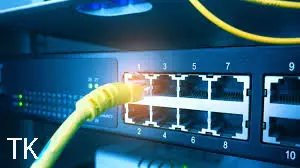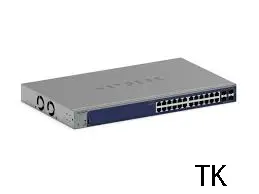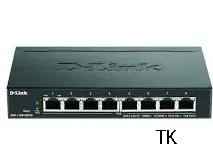Ethernet switches are the primary switches used for connecting multiple devices in a network. Managed and unmanaged Ethernet switches are the two types of Ethernet switches. In this article, we will provide a brief explanation of Managed vs Unmanaged Ethernet Switch.

Introduction to Managed vs Unmanaged Ethernet Switch
Ethernet switches are hardware devices used for connecting multiple devices and are used in a local area network. It transmits data to the correct device through Ethernet cables and reduces the risk of collision. Additionally, it works faster and more efficiently than a hub, and it targets only a specific device. It is also used for sharing files, connecting to the internet, accessing printers, etc. It has two main types, which are given below.
Unmanaged Ethernet Switch
An unmanaged Ethernet switch is a basic network device used for connecting multiple devices. It operates with no configuration and also forwards the data to devices through MAC (Media Access Control) addresses.

Managed Ethernet Switch
This type of Ethernet switch have more features and capabilities than unmanaged Ethernet devices. It also allows configuration, remote access, traffic monitoring, quality of service, etc. It cannot be modified or customized and has a fixed configuration.
Differences between Managed and Unmanaged Ethernet Switches
A brief detail on the differences between managed and unmanaged Ethernet switches Is given below.
Configuration
Managed switches can be configured and also help in controlling traffic and accessing the network. It also helps in monitoring SNMP and NetFlow and adjusting network traffic. It provides better visibility into the network.
Unmanaged switches cannot be controlled and cannot adjust network traffic. They do not require manual configuration and are also easy to set up. It also does not provide visibility into the network.
Cost
Managed switches are more expensive than unmanaged switches because they require software patches. They have also more features and, in return, are more costly.
Unmanaged switches are cheaper than managed switches because they have limited features.
Maintenance
Managed switches require a complex setup and are not ideal for small networks.
Unmanaged switches require low maintenance and are ideal for small networks.It is also ideal for small offices, home networks, etc.
Features
Managed switches have more advanced features than unmanaged switches. It supports VLANs, QoS (Quality of Service), port mirroring, and link aggregation. It also provides tools for traffic analysis and monitoring errors.
Unmanaged switches have limited features and lack traffic analysis and monitoring and VLANs.
Remote management
Managed switches can be monitored and configured; this is the main difference between them.
Unmanaged switches have no remote management, and for troubleshooting, they can be accessed physically.
Security
Managed switches have advanced security features that can be configured.
Unmanaged switches have limited and minimal security features, like VLANs, access control lists, etc.
Scalability
Managed switches have high scalability and are also designed for large enterprises and data centers and have advanced features that improve data and security.
Unmanaged switches have limited scalability and do not have features like VLAN support, which limits growth.
Use Case
Managed switches are used in monitoring, security, and data centers and are suitable for medium to large businesses and enterprises.
Unmanaged switches are used in environments where network control is not needed. Small businesses and home networks use managed switches.
Other types of switches
Some other types of network switches are given below.
Locally managed switches
A locally managed switch is directly connected through a local interface and offers complete control over features. It is suitable for businesses or enterprises that require complete control and on-premises management.
Features
- It provides complete control over features.
- It can be directly managed from a local interface.
- It is best for secure environments.

Cloud-Managed Switches
Cloud-managed switches are managed remotely and require an administrator for internet access, e.g., Aruba Central.
Features
- It provides real-time monitoring.
- Scalability and monitoring are easy.
- Requires an internet connection for proper functioning.

Smart-Managed Switches
Smart-managed switches are also known as web smart switches; they provide a web-based interface. They have intermediate features of fully managed and unmanaged switches. A network administrator uses the network to manage the switches.
Features
- It supports features like VLANs, QoS, and link aggregation that improve its efficiency.
- Its configuration is easier than fully managed switches.
- Customization and monitoring are limited.

Conclusion
If you have a small business and need simple connectivity without any advanced features, then an unmanaged switch is good for you. It is also less costly and is a better choice for simple businesses. But if you have a large business that requires more control, security, scalability, and advanced features, then a managed switch is the smarter choice.
FAQs
Q#1 What is the difference between a switch and a router?
Answer: Both are hardware devices and are used for connecting devices. But a switch uses MAC (Media Access Control) addresses for forwarding data, while a router uses IP (Internet Protocol) addresses for data transmission.
Q#2 Is a managed switch useful for a small business or home?
Answer: If you need a switch for a small business or home to connect a few devices, then an unmanaged switch is enough, but if you want advanced features like VLANs and traffic control, then a managed switch is better.
Q#3 Which is better, a managed or unmanaged Ethernet switch?
Answer: Managed switches have advanced features, but they are also more expensive than unmanaged switches. It depends on your needs. If you are running a small business or anything else that requires a few devices, then unmanaged switches are the perfect choice. But for larger businesses, managed switches will fit best because they have advanced features.
